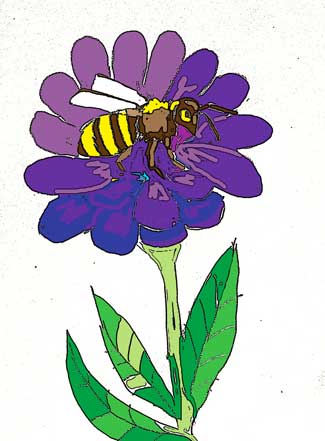Insecticide Exposure Stops Bees from Waggle Dancing!
by Susan Fluegel, PHD

New work confirms that honey bees are damaged by pesticides. Eiri and Nieh (2012) found that honey bees given a single dose of imidacloprid, comparable to what they would naturally receive in nectar from treated fields, became picky eaters. The bees refused less sweet nectar and consumed only very sweet nectar. These prima donna bees ignored all nectar but the sweetest.
In addition, the pesticide exposed bees did less waggle dancing. Waggle dances are performed by foraging bees to inform the rest of the worker bees where to find good food. After the worker bee finds a new pollen and/or nectar source, she returns to the hive to let all the other bees know about it. She expresses this information by a carefully choreographed figure eight waggle dance. The length of the wiggle portion of the dance and the directional orientation of the dance tells the other bees where to find the food. In addition, the more the bee dances the better the food source.
Bees treated with imidacloprid performed 4-10X less dances. Some bees stopped dancing altogether! Less dancing negatively effects the ability of bees to communicate new food sources.
This research is supported by Fischer et al. (2014) who found that nonlethal doses of three neonicotinoids; imidacloprid, clothianidin and thiacloprid; affected honeybees' navigational memory. Bees treated with the pesticides had less success at finding their way home from foraging (homing flight) than untreated bees. The researcher concluded that it was likely that the pesticides either block the retrieval of exploratory navigation memory or alter exploratory navigation memory.
Colony Collapse Disorder (CCD)
The massive and mysterious die off of 30-90% of the honeybees in a hive is called colony collapse disorder (CCD).
How much of a problem is Colony Collapse Disorder (CCD)?
Honeybees pollinate over 1/3 of our food. Without pollination our food supply would decline precariously. According to the annual survey conducted by the U.S. Department of Agriculture (USDA) and the Bee Informed Partnership, 40.6% of honeybee hives suffered CCD in 2014/2015. Loses were spread over the summer and winter months.
The problem has not abated in 2015/2016, with beekeepers reporting colony hive losses of 44%. Due to the rapid decline in bee colonies, the price of bee hives is increasing rapidly. In 2015 the going rate of an 8-10 frame bee hive for pollination was $170-200.
CCD is a problem since bees pollinate so many of our food crops. In addition, bee hives dying means less honey for all of us who love honey!
Learn More to Help Bees!
References:
- Eiri DM, Nieh JC. A nicotinic acetylcholine receptor agonist affects honey bee sucrose responsiveness and decreases waggle dancing. Journal of Experimental Biology, 2012; 215: 2022. Pubmed. doi: 10.1242/jeb.068718
- Fischer J, Muller T, Spatz AK, Greggers U, Grunewald B, Menzel R. Neonicotinoids interfere with specific components of navigation in honeybees. PLoS ONE. 2014; 9: e91364. doi:10.1371/journal.pone.0091364
- Kimura-Kuroda J, Komuta Y, Kuroda Y, Hayashi M, Kawano H. Nicotine-like effects of the neonicotinoid insecticides acetamiprid and imidacloprid on cerebellar neurons from neonatal rats. PLoS One. 2012;7:e32432. Pubmed. doi: 10.1371/journal.pone.0032432 (full text)
- Lu C, Warchol KM, Callahan RA. In Situ Replication of Honey Bee Colony Collapse Disorder. Bulletin of Insectology, 2012;65:99-106. Full text.
- Soderlund DM. Molecular mechanisms of pyrethroid insecticide neurotoxicity: recent advances. Arch Toxicol. 2012;86:165-81. Pubmed. doi: 10.1007/s00204-011-0726-x (full text)
- Tomizawa M, Casida JE. Neonicotinoid insecticide toxicology: mechanisms of selective action. Annu Rev Pharmacol Toxicol. 2005;45:247-68. Pubmed.
